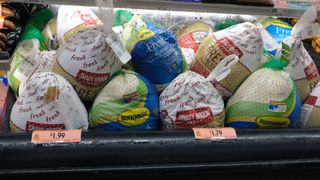Having trouble finding a 20-pound turkey? Blame bird flu.
published

If you're looking for a large turkey for your Thanksgiving table this year, you may be out of luck. Devastating outbreaks of bird flu have hit farms in 46 states since February, limiting the nation's supply of bigger birds.
Although there's been a recent downturn in the rate of outbreaks and farmers have been able to raise the supply of small turkeys in time for the holiday, there hasn't been enough time to increase the supply of 20-pounders (9 kilograms), U.S. Secretary of Agriculture Tom Vilsack said in a call with reporters on Nov. 1, according to Axios.
The strain of bird flu driving the big-bird shortage is known as "highly pathogenic avian influenza (HPAI) H5N1." The virus primarily infects domestic and wild birds, although it's occasionally been found in mammals, including pigs, cats and, rarely, humans, according to the Centers for Disease Control and Prevention (CDC). The rarity of human cases and lack of evidence for human-to-human spread of the virus makes H5N1 a very low risk to the general public, the CDC stresses.
Some wild birds, including migratory ducks and geese, can carry and spread H5N1 without falling ill. However, the pathogen tears through most domestic poultry, leading to organ damage and death in chickens within 48 hours of infection, for example. For that reason, when the pathogen weasels its way into commercial poultry, farmers must euthanize the entire flock to stop the spread.
Related: 3 seals and a fox die from bird flu in rare outbreak at wildlife center
Since February, H5N1 has been detected in 266 commercial flocks and 360 backyard flocks in 46 states, according to the U.S. Department of Agriculture. As of Nov. 3, more than 49 million affected birds had either died of bird flu or been culled after exposure to infected birds, per the CDC. This death toll included more than 8 million turkeys, Axios reported.
The rate of new outbreaks recently slowed as migratory waterfowl, H5N1-carriers who shed the virus in their saliva, nasal secretions and feces, wrapped up their fall migrations, CNET reported.
Typically, commercially raised turkey hens take about 14 weeks to reach maturity and weigh about 15.5 pounds (7 kg) after processing, while toms take 18 weeks to reach 38 pounds (17 kg), the National Turkey Federation says; the hens are most often sold as whole birds, and toms are processed into smaller cuts and other products, like sausage. With the recent downturn in H5N1 outbreaks, farmers have had time to shore up the whole-turkey supply for Thanksgiving — but the birds may be on the small side.
"Turkeys being raised now for Thanksgiving may not have the full amount of time to get to 20 pounds," Vilsack said during the Nov. 1 news conference. "I don't think you're going to have to worry about whether or not you can carve your turkey on Thanksgiving. … It's going to be there, maybe smaller, but it'll be there."


0 تعليقات:
إرسال تعليق
الاشتراك في تعليقات الرسالة [Atom]
<< الصفحة الرئيسية